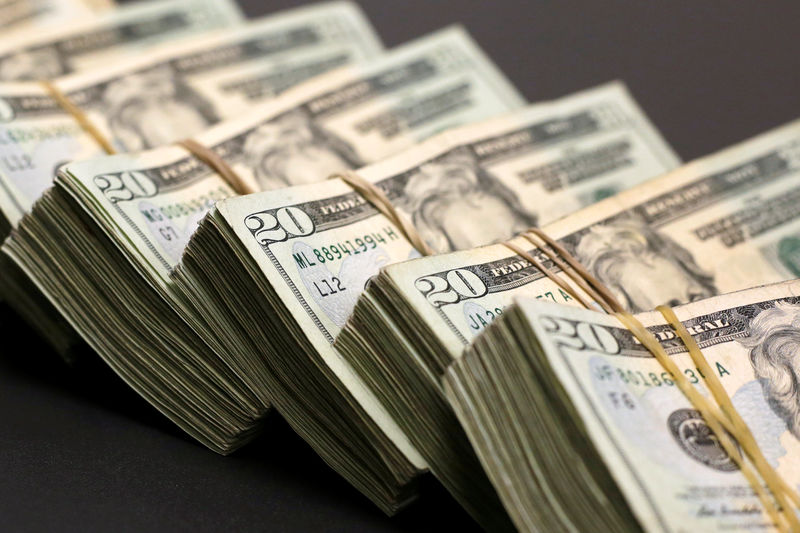(Bloomberg) -- Analysts and traders looking for the dollar to remain under pressure throughout the year could be in for a surprise.
With the greenback extending last year’s drop into 2018 on the back of surging growth overseas and expectations of central bank tightening in Europe and Japan, markets are positioned for more weakness and forecasters see the Dollar Index heading lower. However, investors may be overestimating the headwinds and underestimating the tailwinds for the U.S. currency.
Certainly, dollar bulls had their hopes dashed this week. The greenback, as measured by the Bloomberg Dollar Spot Index, was on the verge of sending a strong bullish technical signal when it closed on Tuesday above its 55-daily moving average for the first time in three months, threatening analyst calls for a euro at $1.30 and the yen at 100 per dollar by year-end.
But a less hawkish-than-expected communique from Federal Reserve Chairman Jerome Powell on Wednesday prompted the dollar to post its biggest sell-off in almost two months, preventing the gauge from closing above that key level for a second day. That was seen negating, or at least postponing, what could be the start of a fresh dollar rally.
However, with almost half of Fed policy makers projecting at least four interest rate increases for 2018, upside risks prevail for the currency given market pricing. Overnight index swap curves suggest that policy makers won’t move three more times until June 2019.
A lack of a meaningful pick-up in price pressure and wage inflation keeping Powell and colleagues cautious isn’t the only burden on the dollar. Uncertainty surrounding Donald Trump’s administration has always been a drag for the greenback, with the U.S. President’s protectionist stance doing the currency no favors.
Still, following the initial headlines and the market’s response to sell the greenback on the belief that the U.S. economy would be hurt by a global trade war, signs quickly emerged that tariff exclusions would be the norm. With that signaling any trade conflict would be mainly contained between the U.S. and China, leveraged accounts that hold dollar shorts at levels close to a three-year low may have to trim back exposure.
Dollar bulls have other potential sources of support. Fading geopolitical risks after Trump’s decision to meet with North Korea’s Kim Jong Un and the aversion of a government shutdown may also back the greenback. And technically, the dollar gauge has rebounded twice this year from a strong weekly Fibonacci support about one percent away from its current level.
Dollar liquidity could be a further factor that pushes traders to fall back in love with the U.S. currency. Tighter dollar funding conditions, as seen through the Libor-OIS spread that has widened to the most since 2009, could see emerging-market exposure that utilized greenback funding to be cut back.
Analysis of the volatility-term structure in euro-dollar and dollar-yen, which together have an almost 50 percent weighting in the Bloomberg Dollar Spot Index, shows options traders see double the chance that the greenback trades 3 percent lower than higher versus its major peers by the end of the year.
This may not only be a reflection of dollar bearishness, but also shows investor appetite to get long currencies where central banks are ready to exit extraordinary stimulus. The European Central Bank is expected to end its quantitative-easing program by December at the latest before hiking rates in the first half of next year, while Bank of Japan Governor Haruhiko Kuroda has said officials will start thinking about how to exit their unprecedented easing around fiscal year 2019.
However, policy makers on both fronts have urged cautiousness and investors face risk of disappointment should central banks move slower than expected. Euro-area data has begun to lose momentum, while Japanese inflation has yet to show it can beat its U.S. counterpart easily. The ECB and the BOJ could eventually enter a hiking rate cycle that resembles more of a Bank of England-style “one and done,” rather than a Fed-like sequence.
There is already a lot of negativity priced in the dollar and much hype into assets outside the U.S. A positive surprise for the greenback could be closer than many think.
What to Watch:
- EU and U.K. negotiators discuss post-Brexit Irish border issues in Brussels on Monday March 26
- International Monetary Fund Managing Director Christine Lagarde gives a lecture on strengthening the EU the same day
- Speeches by policy makers next week include: Cleveland Fed President Loretta Mester, New York Fed President William Dudley, Bank of Finland Governor Erkki Liikanen, Atlanta Fed President Raphael Bostic, Philadelphia Fed President Patrick Harker
- Euro-area consumer confidence; U.S. PCE deflator, GDP, personal spending; U.K. GDP; see data calendar
